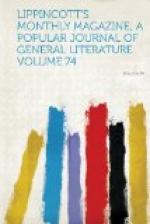The difference between a Novel and a Novelette is one of length only: a Novelette is a brief Novel. But the difference between a Novel and a Short story is a difference of kind, A true Short-story is something other and something more than a mere story which is short. A true Short-story differs from the Novel chiefly in its essential unity of impression. In a far more exact and precise use of the word a Short-story has unity as a Novel cannot have it. Often, it may be noted by the way, the Short-story fulfills the three false unities of the French classic drama: it shows one action in one place on one day. A Short-story deals with a single character, a single event, a single emotion, or the series of emotions called forth by a single situation. Poe’s paradox that a poem cannot greatly exceed a hundred lines in length under penalty of ceasing to be one poem and breaking into a string of poems, may serve to suggest the precise difference between the Short-story and the Novel, The Short-story is the single effect, complete and self-contained, while the Novel is of necessity broken into a series of episodes. Thus the Short-story has, what the Novel cannot have, the effect of “totality,” as Poe called it, the unity of impression. The Short-story is not only not a chapter out of a Novel, or an incident or an episode extracted from a longer tale, but at its best it impresses the reader with the belief that it would be spoiled if it were made larger or if it were incorporated into a more elaborate work. The difference in spirit and in form between the Lyric and the Epic is scarcely greater than the difference between the Short-story and the Novel; and “The Raven” and “How we brought the good news from Ghent to Aix” are not more unlike “The Lady of the Lake” and “Paradise Lost,” in form and in spirit, than “The Luck of Roaring Camp” and “The Man without a Country”—two typical Short-stories—are unlike “Vanity Fair” and “The Heart of Midlothian,”—two typical Novels.
Another great difference between the Short-story and the Novel lies in the fact that the Novel, nowadays at least, must be a love-tale, while the Short-story need not deal with love at all. Although “Vanity Fair” was a Novel without a hero, nearly every other Novel has a hero and a heroine, and the novelist, however unwillingly, must concern himself in their love-affairs. But the writer of Short-stories is under no bonds of this sort. Of course he may tell a tale of love if he choose, and if love enters into his tale naturally and to its enriching, but he need not bother with love at all unless he please. Some of the best of Short-stories are love-stories too,—Mr. Aldrich’s “Margery Daw,” for instance, Mr. Stimpson’s “Mrs. Knollys,” Mr. Bunner’s “Love in Old Clothes;” but more of them are not love-stories at all. If we were to pick out the ten best Short-stories, I think we should find that fewer than half of them made any mention at all of love. In “The Snow Image” and in “The Ambitious Guest,”




